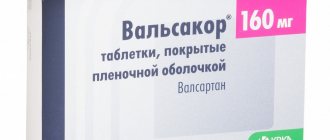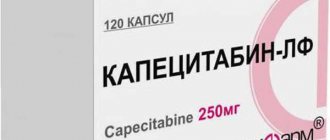Release form
- Ketorolac tablets are white-coated, biconvex. 10 such tablets in contour packaging; 1,2, 5 or 10 packs in a paper pack. 10 such tablets in a polymer jar; one such jar in a pack of paper. 25 of these tablets in contour packaging; 2 or 4 packs in a paper pack.
- Ketorolac (i.v., i.m.) in ampoules contains a transparent solution of white-yellow color. 1 or 2 ml of this solution in an ampoule; 5 ampoules in contour packaging, 1 or 2 such packages in a cardboard box. 1 or 2 ml of this solution in an ampoule; 10 such ampoules in a cardboard box.
Name
The INN of the drug in question is Ketorolac.
Latin name
In Latin the drug is called Ketorolacum.
Chemical name
According to the IUPAC nomenclature, the active component of the drug is called (±)-5-benzoyl-2,3-dihydro-1H-pyrrolizine-1-carboxylic acid, it is isolated as a compound with 2-amino-2-hydroxymethyl-1-butanol.
The drug is produced not only in ampoules, but also in tablets.
Pharmacodynamics and pharmacokinetics
Pharmacodynamics
It has a strong analgesic effect, moderate antipyretic and anti-inflammatory effect.
They are associated with indiscriminate inhibition of the enzyme cyclooxygenase of the first and second types in peripheral tissues, resulting in inhibition of the synthesis of prostaglandins - mediators of pain, inflammation and thermoregulation.
The drug has no effect on opioid receptors, does not cause addiction, does not depress breathing, and does not have a sedative or anxiolytic effect.
The strength of the analgesic effect is comparable to morphine and superior to other drugs in its group.
After oral administration, the analgesic effect is recorded after one hour, the greatest effect – after one to two hours. After an intramuscular injection, the onset of the analgesic effect is recorded after 30 minutes, the greatest effect – after one to two hours.
Pharmacokinetics
When taken internally and when administered by injection, it is actively absorbed from the intestines and tissues. The maximum concentration in the blood is recorded after 40-50 minutes, both after oral administration and after intramuscular injection. Eating does not affect absorption. Plasma protein binding is about 99%.
The half-life is approximately 6 hours. 90% of the dose is excreted by the kidneys, in its original form - 60%; the remaining amount is excreted through the digestive tract.
pharmachologic effect
The active component of the drug is a non-steroidal anti-inflammatory drug and is a derivative of acetic acid. It has not only anti-inflammatory, but also a strong analgesic effect, exhibits antipyretic and antiplatelet properties, and eliminates edema.
The drug is packaged in jars or blisters.
Its mechanism of action is the nonspecific inhibition of both forms of cyclooxygenase, which is involved in the biosynthesis of prostanoids, including prostaglandins. As a result, the severity of inflammatory symptoms and the weakening or disappearance of pain are reduced.
The analgesic effect of Ketorolac is superior to other NSAIDs. Its strength is comparable to morphine, of which it is only 2.5 times weaker. This allows this medication to be used not only as an antirheumatic drug, but also as an analgesic for patients with cancer.
Pharmacokinetics
Absorption occurs quickly: with intramuscular administration, maximum concentrations are reached in 15-30 minutes (depending on the dose), with oral administration - in 40 minutes. The presence of fatty foods in the stomach impairs absorption from the gastrointestinal tract. The analgesic effect appears 30 minutes after the injection and reaches its maximum after 1-2 hours. When taken orally, the analgesic effect is fully revealed after about 2.5 hours. The duration of exposure lasts up to 6 hours, sometimes up to 8 hours.
The main burden of drug elimination falls on the kidneys.
The bioavailability of the active substance reaches 100%. About 99% of ketorolac binds to blood proteins, so hemodialysis is useless. The drug can pass into breast milk. Metabolization with the formation of inactive products is carried out by the liver. The main burden of drug elimination falls on the kidneys. A small proportion of the drug is evacuated along with feces. With normal renal activity, the half-life reaches 9 hours. With age, this indicator increases; liver dysfunction does not affect it.
Indications for use
Moderate to severe pain syndrome :
- toothache;
- pain of traumatic etiology;
- pain in the postoperative and postpartum period;
- pain due to cancer ;
- dislocations , sprains ;
- arthralgia , neuralgia , myalgia , radiculitis ;
- rheumatic diseases.
Used for symptomatic therapy, relief of inflammation and pain at the time of use, does not affect the development of the disease.
What does Ketorolac help with?
The analgesic effect of the drug is especially appreciated. Indications for its use:
- pain syndrome due to injuries;
- headaches, migraines;
- pain, including high intensity, during the postpartum or postoperative period;
- abdominal pain;
- myalgia;
- arthralgia;
- rheumatoid manifestations;
- radiculitis;
- neuralgia;
- toothache;
- oncological lesions;
- diffuse pain.
The medicine also stops inflammation, reducing phenomena associated with this process, such as fever, swelling, and limited mobility of the joint apparatus. But it should be borne in mind that this is a symptomatic remedy that does not affect the development of the underlying disease, but only facilitates its course and relieves acute attacks. Therefore, it is not applicable for therapeutic purposes as a single drug and should be prescribed in combination with other drugs.
Contraindications
- Combination (complete or incomplete) of bronchial asthma , intolerance to aspirin (or other drugs in this group) and recurrent polyposis of the paranasal sinuses and nose .
- Hypersensitivity.
- Hypovolemia.
- Intolerance pyrazolone drugs .
- Exacerbation of erosive and ulcerative diseases of the gastrointestinal tract.
- Hypocoagulation , high risk of bleeding.
- Severe kidney or liver damage , liver disease.
- Condition after coronary artery bypass surgery .
- Hyperkalemia.
- 3rd trimester of pregnancy, childbirth and lactation.
- Inflammatory intestinal lesions.
- Age less than 16 years.
Use with caution for: bronchial asthma , alcoholism , chronic heart failure, cholecystitis , postoperative period, arterial hypertension , edema syndrome, kidney damage, active hepatitis, cholestasis, systemic lupus erythematosus, sepsis, coronary heart disease, dyslipidemia , cerebrovascular diseases, peripheral damage arteries, diabetes mellitus, ulcerative lesions of the digestive tract in the past, H. pylori infection, prolonged use of other non-steroidal anti-inflammatory drugs , old age, 1st and 2nd trimesters of pregnancy.
What side effects can Ketorolac cause?
The use of the drug in question can have various negative consequences. The following side effects are possible:
- epigastric pain;
- nausea, vomiting;
- indigestion;
- flatulence;
- stomatitis;
- loss of appetite;
- mucosal erosion, bleeding in the gastrointestinal tract;
- cholestasis;
- hepatitis;
- pancreatitis;
- intestinal inflammation;
- respiratory distress, bronchospasm;
- rhinitis;
Rhinitis may occur after using the drug. - headache;
- dizziness, asthenia, fainting;
- paresthesia;
- sweating;
- sleep disturbance;
- hallucinations;
- tremor, convulsions;
- psycho-emotional reactions;
- absent-mindedness, memory impairment;
- non-bacterial meningitis;
- urinary disorders, renal failure, nephritis;
- blood in urine;
- anemia, thrombocytopenia, purpura;
- pain in the lumbar region;
- swelling of the face and/or limbs, swelling of the eyelids;
- hyperemia, itching, urticaria;
- change in pressure in one direction or another;
- cardiac dysfunction, stroke, heart attack;
- visual, taste, auditory abnormalities;
- bleeding of various locations, including rectal;
- anaphylaxis;
- local reactions after injections - itching, burning, pain.
Ketorolac may cause pain in the lower back.
All alarming symptoms should be reported to your doctor so that the dosage can be adjusted or the drug replaced.
Side effects
- Reactions from the circulatory system: changes in pressure, bradycardia , rapid heartbeat , fainting.
- Reactions from the digestive system: abdominal pain, diarrhea, flatulence, nausea, constipation , vomiting, thirst , gastritis, stomatitis , erosive and ulcerative changes in the digestive tract, liver damage.
- Reactions from the nervous system: paresthesia , anxiety, sleep disturbances , drowsiness , depression , visual disturbances, dizziness , movement disorders.
- Reactions from the respiratory system: attacks of suffocation.
- Reactions from the genitourinary system: oliguria , increased urination, polyuria, proteinuria, hematuria, azotemia, acute renal failure .
- Reactions from the hematopoietic system: nosebleeds, anemia , eosinophilia, thrombocytopenia.
- Metabolic reactions: edema , hypokalemia , increased creatinine or urea in the blood, hyponatremia.
- Allergic reactions: hemorrhagic rash, Stevens-Johnson syndrome , urticaria , Quincke's edema , Lyell's syndrome , anaphylactic shock, bronchospasm, myalgia .
- Other reactions: fever .
- Local reactions: pain in the injection area.
Side effects
During the period of use of the described pharmacological drug, the following body disorders may develop:
- Peripheral and central nervous system: drowsiness, cephalgia, dizziness; aseptic meningitis (including fever, convulsions, migraines, stiff neck), excessive activity (including severe anxiety, mood swings), depressive disorders, hallucinations, psychosis.
- Respiratory system: dyspnea, pulmonary edema, bronchospasm, rhinitis, swelling of the laryngeal tissue (including difficulty breathing, shortness of breath).
- Heart and blood vessels: increased pressure, fainting.
- Digestive system: gastralgia, diarrhea, flatulence, vomiting, stomatitis, constipation, feeling of excessive stomach fullness, nausea, loss of appetite, erosive and ulcerative lesions of the structures of the digestive tract (including those accompanied by bleeding or perforation - abdominal pain, melena, spasm in the epigastric zone , nausea, vomiting with blood, heartburn), cholestatic jaundice, liver inflammation, acute pancreatitis, hepatomegaly.
- Coagulation system: nasal or rectal bleeding, bleeding from postoperative wounds.
- Hematopoietic system: eosinophilia, leukopenia, anemia.
- Urinary system: lower back pain, acute renal failure, hematuria, azotemia, hemolytic-uremic syndrome (hemolytic anemia, thrombocytopenia, purpura), decreased or increased urine volume, edema of renal origin, frequent urination, nephritis.
- Skin: purpura, rashes (including maculopapular), exfoliative dermatitis (including fever, peeling, redness or thickening of the skin, swelling or tenderness of the tonsils), Stevens-Johnson syndrome, Lyell's syndrome.
- Sense organs: ringing in the ears, changes in visual functions (blurred vision), hearing loss.
- Local reactions: burning or pain at the injection site.
- Allergic phenomena - anaphylactoid reactions (including changes in facial skin tone, urticaria, skin rash, dyspnea or tachypnea, periorbital edema, swelling of the eyelids, shortness of breath, difficulty or wheezing).
- Other adverse reactions: weight gain, swelling (including of the face, ankles, legs, fingers, feet), increased sweating, swelling of the tongue, fever.
Instructions for use of Ketorolac (Method and dosage)
Ketorolac tablets instructions for use recommend using them orally. Single dose - 10 mg. The next time you use it, you can take 10 mg up to four times a day; the highest daily dose should not be more than 40 mg. The duration of treatment is up to 5 days.
Ketorolac injections instructions for use recommend that when administered intramuscularly, stick to a single dose of up to 30 mg once every 4-6 hours. The highest dose is 90 mg (three ampoules) per day. The longest duration of use of the drug is up to 2 days.
Method of use and dosage regimen
The pharmacological drug “Ketorolac” in solution is administered intravenously (in a stream) in a slow flow (at least 15 seconds) or deep intramuscularly in the minimum effective dosage, which is selected by a specialist depending on the severity of the pain syndrome and the patient’s response. If necessary, simultaneous use with opioid analgesics in reduced dosages is permitted.
Depending on the severity of the pain syndrome, a single adult dosage (intramuscular or intravenous) ranges from 10 to 30 mg. Patients over 65 years of age or with changes in kidney function are usually prescribed 10-15 mg.
When repeatedly administering parenterally the drug “Ketorolac” in ampoules, the following dosing rules apply:
- Intramuscular administration: for patients under 65 years of age and after 16 years of age - 10-60 mg at the first injection, then - at intervals of 6 hours, 10-30 mg; for elderly patients (after 65 years) or for impaired renal activity - 10-15 mg every 6 hours.
- Intravenous administration: for patients under 65 years of age and over 16 years of age - 10-30 mg for the first injection, in a stream, subsequently - 10-30 mg every 6 hours, the initial dosage for continuous infusion using an infusion pump - 30 mg, after which the rate infusion should be 5 mg per hour; for elderly patients (after 65 years) or for kidney disorders - every 6 hours, 10-15 mg as a bolus.
The maximum daily dosage of Ketorolac injections for intravenous and intramuscular administration is:
- under 65 years of age and children over 16 years of age – 90 mg;
- elderly patients (after 65 years) or with impaired renal function - 60 mg.
Continuous intravenous administration should not last more than 24 hours. The duration of the course is no more than 5 days. When transferring a patient from intravenous and intramuscular administration to taking the drug Ketorolac orally, the total daily dosage per day should not exceed that administered by injection.
Interaction
Use with other drugs from the same group (OKPD - non-steroidal anti-inflammatory drugs ), glucocorticosteroids, corticotropin, ethanol, calcium supplements increases the risk of ulceration of the gastrointestinal tract and bleeding from the stomach and intestines.
Co-administration with heparin , coumarin derivatives, thrombolytics ( Streptokinase, Alteplase ), cephalosporins, antiplatelet agents, valproic acid and aspirin increases the risk of bleeding.
Ketorolac weakens the effect of diuretic and antihypertensive drugs.
Use together with methotrexate increases hepato- and nephrotoxicity .
Ketorolac enhances the effect of narcotic analgesics.
Myelotoxic drugs enhance the hematotoxic effect of the drug.
Features of application
Before prescribing, you should make sure that there is no history of allergy to NSAIDs.
Combining Ketorolac with narcotic drugs is allowed.
The effect of the drug on platelet aggregation continues for 1-2 days after taking the last dose.
In case of coagulation disorders, monitoring of blood composition is required, especially for patients after surgery.
Long-term use of the drug should be avoided. Combination with other NSAIDs increases the risk of cardiac dysfunction, possible dehydration and surges in blood pressure.
During pregnancy and lactation
The drug is not prescribed to pregnant women and nursing mothers.
Effect on concentration
While taking Ketorolac, many patients experience various reactions from the central nervous system. Therefore, it is advisable to refrain from driving a car or operating potentially dangerous machinery.
While taking Ketorolac, it is advisable to refrain from driving.
special instructions
Before prescribing the drug, it is necessary to find out about the presence of a previous allergy to other non-steroidal anti-inflammatory drugs .
Hypovolemia increases the risk of developing kidney toxicity.
If necessary, Ketorolac can be prescribed with narcotic analgesics . The drug should not be used for premedication or to maintain anesthesia.
Do not use the product simultaneously with paracetamol for more than 5 days.
To reduce the risk of developing gastropathy , misoprostol, antacids, and omeprazole are prescribed simultaneously .
To reduce the risk of side effects, the lowest effective dose should be used for the shortest possible course.
During treatment with the drug, you must be careful when driving.
Special Recommendations
When using the drug "Ketorolac" simultaneously with other anti-inflammatory non-steroidal medications, decompensation of heart function, fluid retention, and increased blood pressure may occur. In order to reduce the likelihood of developing gastropathy caused by the use of these drugs, antacids, Misoprostol, and Omeprazole are prescribed.
The effect on platelet aggregation after administration of the drug "Ketorolac" persists for 48 hours. Hypovolemia increases the risk of negative side reactions from the urinary organs.
When concomitant therapy with paracetamol is used, Ketorolac should not be used for more than 3 days. For patients with impaired blood coagulation processes, the drug is prescribed only with constant monitoring of platelet volume, especially in the postoperative period, which requires careful monitoring of hemostasis. Due to the fact that most patients during treatment develop side effects from the central nervous system (dizziness, cephalalgia), performing work that requires high attention and speed of reactions (driving vehicles, working with machinery) is not recommended.
Analogs
Level 4 ATC code matches:
Voltaren
Rapten
Zerodol
Dickloberl Retard
Dikloberl N 75
Dicloberl
Ketanov
Dolak
Panoxen
Naklofen Duo
Naklofen
Olfen-100
Olfen-75
Neurodiclovit
Nizilat
Fanigan
Aertal
Ortofen
Flamidez
Ketarolac analogues: Ketanov, Ketorol, Ketonort, Ketorolac-Credofarm and others.
Ketarolac price, where to buy
In Russia, the price of Ketorolac No. 10 ampoules is 99-101 rubles, the price of Ketorolac No. 20 tablets is approximately 18 rubles. In Ukraine, ampoules of drug No. 10 cost 54-75 hryvnia, tablets No. 10 cost 9-25 hryvnia.
- Online pharmacies in RussiaRussia
- Online pharmacies in UkraineUkraine
- Online pharmacies in KazakhstanKazakhstan
ZdravCity
- Ketorolac solution for intravenous and intramuscular administration.
30mg/ml apm. 1 ml 10 pcs. Biokhimik OJSC 60 rub. order - Ketorolac solution for intravenous and intramuscular injection. 30mg/ml amp. 1ml No. 10Sintez AKO OJSC
94 RUR order
- Ketorolac tablets p.p.o. 10 mg 20 pcs. JSC Tatkhimfarmpreparaty
33 rub. order
- Ketorolac solution for intravenous and intramuscular administration. 30mg/ml amp. 1ml 10 pcs. Biosynthesis JSC
86 rub. order
- Ketorolac tab. p/o captivity. 10 mg No. 20 Borisov Medical Preparations Plant OJSC
30 rub. order
Pharmacy Dialogue
- Ketorolac (amp. 30 mg/ml 1 ml No. 10) Biosynthesis OJSC
50 rub. order
- Ketorolac (amp. 30 mg/ml 1 ml No. 10) Sintez (Kurgan) OJSC
83 RUR order
- Ketorolac (amp. 30 mg/ml 1 ml No. 10) Eskom
59 RUR order
show more
PaniPharmacy
- KETOROLAC ampoule Ketorolac r/r d/in.
3% 1ml. No. 10 Ukraine, Health LLC 99 UAH. order - KETOROLAC tablets Ketorolac tablets. 10mg No. 10 Ukraine, Health LLC
18 UAH order
show more
Conditions for dispensing from pharmacies
Access to this medicine is limited.
During treatment, drinking alcohol is contraindicated.
Is it sold without a prescription?
The drug must be dispensed only with a prescription.
What is the price
The cost of film-coated tablets is from 24 rubles. for 20 pcs. The price of the injection solution is from 6 rubles. per ampoule.


